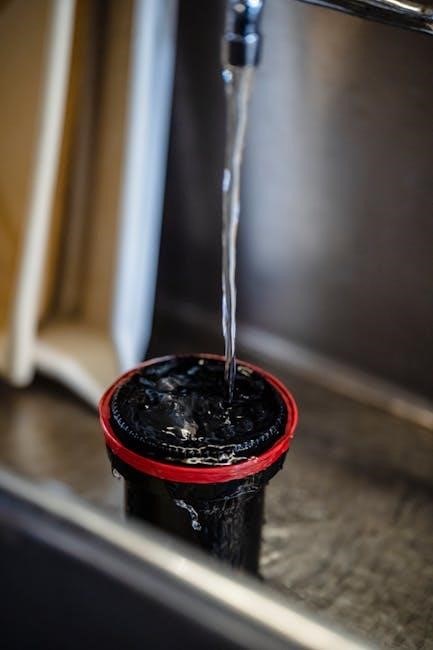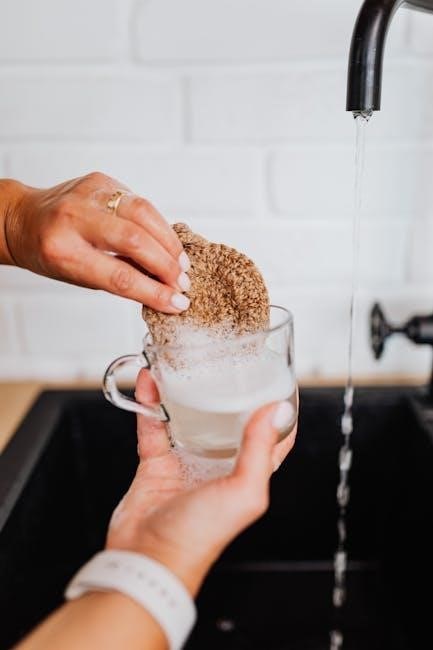Welcome to the Fleck 5600 Water Softener Manual, your comprehensive guide for installing, operating, and maintaining your water softening system. This manual ensures proper setup and optimal performance.
1.1 Overview of the Fleck 5600 Water Softener System
The Fleck 5600 Water Softener System is a high-efficiency, metered ion exchange water treatment solution designed for residential use. It features a advanced control valve, ensuring precise water flow measurement and regeneration. The system includes a resin tank for softening and a brine tank for salt storage. Built for durability and reliability, it operates within specific temperature and humidity limits, making it suitable for various home environments while maintaining optimal performance and water quality.
1.2 Importance of the Manual for Installation and Maintenance
The Fleck 5600 Water Softener Manual is essential for proper installation, operation, and maintenance of the system. It provides step-by-step instructions, ensuring compliance with manufacturer recommendations and plumbing codes. The manual also includes troubleshooting guides and maintenance tips to optimize performance and extend the system’s lifespan. Adhering to the manual ensures safety, efficiency, and effective water softening, making it a critical resource for homeowners and installers alike.
Installation Instructions
Proper installation ensures optimal performance. Follow the Fleck 5600 Water Softener Manual for location, connections, and setup. Ensure compliance with local plumbing codes and manufacturer guidelines.
2.1 Location Requirements for the Water Softener
Install the Fleck 5600 Water Softener near a clean drain and on a level surface. Ensure it is protected from freezing temperatures and extreme humidity. The system operates best in areas with a maximum relative humidity of 80% at temperatures up to 31°C, decreasing linearly to 50% at 40°C. Keep the unit away from direct sunlight and moisture extremes for optimal performance and longevity. Always follow local plumbing codes for installation.
2.2 Connecting Inlet, Outlet, and Drain Lines
Connect the Fleck 5600 Water Softener inlet and outlet lines according to the manufacturer’s guidelines and local plumbing codes. Ensure the drain line is properly sized and installed, with an uninterrupted flow path. Use food-grade materials to prevent contamination. The brine tank drain line should be within 20 feet of the softener; Follow the manual for specific fitting recommendations to avoid leaks and ensure proper system operation. Always test connections before use.
2.3 Brine Tank Setup and Placement Guidelines
Position the brine tank near the Fleck 5600 Water Softener, ensuring it is level and elevated to prevent overflow. Place it within 20 feet of the softener for optimal operation. Use a drain line flow controller to regulate brine discharge. Keep the tank away from freezing temperatures and ensure the area is well-ventilated. Maintain proper humidity levels (up to 80% at 31°C) to prevent corrosion. Secure the tank to avoid shifting during operation.
Operating the Fleck 5600 Water Softener
Learn to operate the Fleck 5600 efficiently by understanding the control valve functions, monitoring water flow, and managing the brine tank refill process to ensure optimal softening performance.
3.1 Understanding the Control Valve and Its Functions
The control valve is the brain of the Fleck 5600, regulating water flow and system cycles. It manages the directional flow of water during softening, backwash, and rinse phases. The valve ensures proper measurement of water usage and triggers regeneration when necessary. Understanding its functions is key to maintaining optimal performance and extending the system’s lifespan. Regular inspection ensures smooth operation and prevents potential issues. Proper valve alignment is crucial for accurate water metering and cycle control.
3.2 Manually Indexing the Softener Control
Manually indexing the softener control involves moving it to the service position to initiate water flow into the resin tank. Once the flow stops, open a softened water tap to ensure proper function. This process ensures the system operates correctly and maintains water quality. Always follow the manual’s guidelines for accurate indexing and system performance. Regular checks ensure optimal operation and prevent issues related to improper indexing.
3.4 Monitoring Water Flow and Brine Tank Refill
Monitoring water flow ensures the system operates efficiently, while observing the brine tank refill guarantees proper salt levels. Check the brine tank regularly to maintain the salt level above the water line. Ensure the drain line is not clogged to prevent refill issues. Proper monitoring prevents overfilling and maintains optimal softening performance. Regular checks help identify potential problems early, ensuring consistent water quality and system longevity.

Maintenance and Upkeep
Regular maintenance ensures optimal performance. Check the system monthly, ensure salt levels, and clean components as needed. Schedule professional servicing every 6-12 months for best results.
4.1 Routine Care and Maintenance Tasks
Perform routine checks on salt levels, ensuring they remain above water in the brine tank. Manually index the control valve periodically to maintain optimal flow. Inspect drain lines for blockages and clean as needed. Regularly test water hardness to confirm softening efficiency. Schedule professional servicing every 6-12 months to replace worn parts and ensure system longevity. Keep the resin tank clean and free from debris.
4;2 Salt Level Management in the Brine Tank
Monitor the salt level in the brine tank regularly, ensuring it remains above the water level. Use high-quality salt pellets or solar salt for optimal performance. Avoid using rock or granulated salt, as they may cause operational issues. Refill the tank when the salt level is low to maintain proper brine production. Never fill the tank more than 2/3 full to prevent salt bridges. Regular checks ensure consistent water softening and system efficiency.
4.3 Cleaning and Disinfecting the System
Regularly clean and disinfect the Fleck 5600 water softener to ensure optimal performance and hygiene. Dissolve 1 tablespoon of chlorine in 1 gallon of water and pour it into the resin tank. Place the system in service mode to allow the solution to flow through the resin and distribution system. Rinse thoroughly with fresh water to remove any residual chlorine. Avoid using harsh chemicals that may damage components. Disinfecting maintains water quality and system efficiency. Always rinse after cleaning to prevent any chemical taste in the water.

Troubleshooting Common Issues
This section helps diagnose and resolve common issues with the Fleck 5600, ensuring optimal performance and addressing problems like flow measurement, hard water, and drain malfunctions.
5.1 Diagnosing Flow Measurement Problems
Flow issues often stem from faulty meters or incorrect valve settings. Check the meter’s accuracy and ensure the control valve is properly aligned. Inspect inlet/outlet lines for blockages and verify the drain line flow controller is functioning. If problems persist, consult the manual for recalibration steps or consider replacing the meter to restore accurate water flow measurement and system efficiency.
5.2 Resolving Hard Water Issues After Installation
Hard water issues post-installation may indicate incorrect control valve settings or insufficient salt levels. Check the control valve to ensure it’s properly programmed and cycling through regeneration phases. Verify that the brine tank has adequate salt levels, as low salt can prevent softening. Allow the system to complete a full regeneration cycle before testing water hardness again. If problems persist, refer to the manual for troubleshooting guides or contact a professional for assistance.
5.3 Addressing Drain Line Flow Controller Malfunctions
Malfunctions in the drain line flow controller can disrupt proper regeneration. Check for blockages and ensure the drain line is installed as per local codes. Verify the flow controller is functioning correctly; reset or clean it if necessary. Ensure the system operates within the recommended temperature and humidity limits to prevent issues. Always follow the manufacturer’s installation and maintenance guidelines to maintain optimal performance and prevent future malfunctions.
System Components and Functionality
The Fleck 5600 system includes a control valve, resin tank, brine tank, and drain flow controller, each designed for efficient water softening and regeneration processes and optimal performance.
6.1 Residential Air Check Valve Operation
The Residential Air Check Valve ensures proper drainage and prevents backflow in the Fleck 5600 system. It allows air to escape during regeneration while blocking water flow reversal, maintaining system integrity and efficiency. This valve is crucial for smooth operation and is typically installed near the resin tank to facilitate optimal water flow and drainage processes.
6.2 Role of the Resin Tank and Distribution System
The resin tank in the Fleck 5600 system houses the resin beads responsible for ion exchange, removing hardness minerals from water. The distribution system ensures even water flow through the resin, maximizing softening efficiency. Proper installation and maintenance of these components are critical for consistent water softening performance and system longevity. They work together to deliver soft water throughout your home effectively.
6.3 Understanding the Meter and Its Calibration
The Fleck 5600 meter measures water flow to determine regeneration cycles. Proper calibration ensures accurate measurements and efficient system operation; Refer to the manual for calibration steps to maintain optimal performance. Incorrect calibration can lead to issues like improper regeneration, affecting water softening. Regular checks and adjustments are essential for consistent soft water delivery and system longevity.

Warranty and Manufacturer Recommendations
The Fleck 5600 water softener is backed by a comprehensive warranty program, ensuring coverage for parts and labor under specific conditions. Proper installation and regular maintenance are required to maintain warranty validity. Always follow manufacturer recommendations to ensure compliance and optimal system performance.
7.1 Pentair Quality System EMEA Warranty Details
The Pentair Quality System EMEA warranty ensures comprehensive coverage for the Fleck 5600 water softener, offering protection for parts and labor under specific conditions. This warranty applies to products distributed within the EMEA region and requires adherence to installation and maintenance guidelines. Proper registration and compliance with manufacturer recommendations are essential to validate the warranty. The program reflects Pentair’s commitment to quality and customer satisfaction, providing peace of mind for system owners.
7.2 Compliance with Plumbing Codes and Standards
Ensure the Fleck 5600 water softener is installed in compliance with local plumbing codes and regulations. Adherence to these standards guarantees safety, proper function, and environmental protection. The system must meet all applicable plumbing requirements, including water supply connections and drain line installations. Always consult local authorities for specific guidelines to avoid non-compliance issues and ensure the system operates efficiently and safely. Proper installation is key to maintaining optimal performance and longevity.
Environmental and Safety Considerations
The Fleck 5600 operates within specific environmental conditions: 34–120°F and up to 80% humidity. Protect the system from freezing and ensure proper ventilation for safe operation.
8.1 Operating Temperature and Humidity Limits
The Fleck 5600 water softener operates effectively within a temperature range of 34°F to 120°F (1°C to 49°C). The system requires a maximum relative humidity of 80% at temperatures up to 31°C, with a linear reduction to 50% humidity at 40°C. Ensure the environment stays within these limits to maintain optimal performance and prevent damage to components.
8.2 Protecting the System from Freezing Conditions
To prevent damage from freezing, ensure the Fleck 5600 water softener is installed in a protected, dry, and non-freezing area. If exposure to freezing temperatures is unavoidable, insulate the system and pipes. In extreme cases, drain the water from the softener and brine tank to avoid ice formation. Always follow manufacturer guidelines for winterizing the system to maintain functionality and longevity.

Start-Up Instructions
Welcome to the Fleck 5600 Water Softener Manual start-up guide. Ensure all connections are secure, power up the system, and check for leaks. Initialize water flow according to the manual for optimal performance.
9.1 Initial System Setup and Testing
Begin by installing the system in a protected, level area. Connect inlet, outlet, and drain lines securely. Ensure the brine tank is properly placed and filled with salt. Manually index the control valve to the service position and allow water to flow into the resin tank. Check for leaks and ensure all connections are tight. Once setup is complete, test the system by running a full cycle to confirm proper operation and water softening.
9.2 Ensuring Proper Water Flow and Softening
After initial setup, check the water flow by opening a softened water tap to ensure smooth operation. Verify the control valve is functioning correctly and connections are leak-free. Monitor the brine tank to maintain adequate salt levels, as low levels can disrupt softening. Ensure the drain line is clear and functioning properly. Finally, test the water hardness to confirm softening effectiveness, ensuring optimal performance of your Fleck 5600 system.
